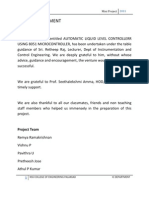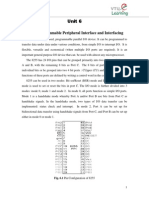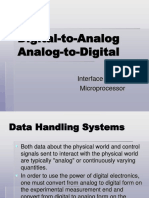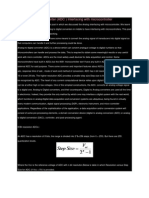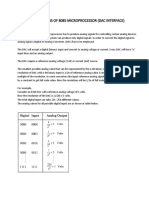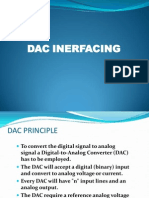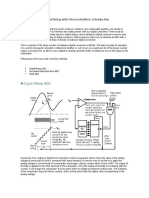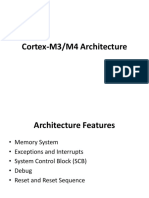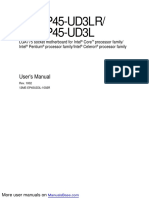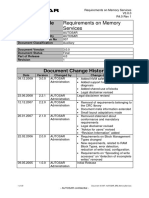Micro Process
Micro Process
Uploaded by
Honey BhatiaCopyright:
Available Formats
Micro Process
Micro Process
Uploaded by
Honey BhatiaOriginal Description:
Copyright
Available Formats
Share this document
Did you find this document useful?
Is this content inappropriate?
Copyright:
Available Formats
Micro Process
Micro Process
Uploaded by
Honey BhatiaCopyright:
Available Formats
Temp
eratu
re
contr
ol
Conversion subroutine::
CONVERSION:
MVI A,00H
OUT PB ; Send address to select IN0
MVI A,08H ;Latch address by giving ALE High
OUT PB
BACK: MVI A,18H
OUT PB ; Make SOC High
MVI A,08H
OUT PB ; Make SOC Low
MVI A,00H
OUT PB ; Make ALE Low
LOOP: IN PC
ANI 01H
JZ LOOP ; Wait for EOC
IN PA
RET ; Return value and store Accumulator
MVI A,98H
OUT CWR
L2: CALL CONVERSION
CPI 80H
JC L1
MVI A,0EH
OUT CWR
JMP L2
L1: MVI A,OFH
OUT CWR
JMP L2
SUBROUTINE conversion :
MVI A,00H
OUT PB
MVI A,08H
OUT PB
MVI C,0AH
L3: DCR C
JNZ L3
MVI A,18H
OUT PB
MVI A,08H
OUT PB
MVI A,00H
OUT PB
L4: IN PC
ANI 01H
JZ L4
IN PA
RET
Program:
MVI A,98H
OUT CWR
L2: CALL CONVERSION
CPI 80H
JC L1
MVI A,0EH
OUT CWR
JMP L2
L1: MVI A,OFH
OUT CWR
JMP L2
Interfacing Analog to Digital Data
Converters
In most of the cases, the PIO 8255 is used for interfacing
the analog to digital converters with microprocessor.
We have already studied 8255 interfacing with 8086 as an
I/O port, in previous section. This section we will only
emphasize the interfacing techniques of analog to digital
converters with 8255.
The analog to digital converters is treaded as an input
device by the microprocessor, that sends an initialising
signal to the ADC to start the analogy to digital data
conversation process. The start of conversation signal is a
pulse of a specific duration.
M Krishhna Kumar MAM/M3/LU9g/V1/2004 2
The process of analog to digital conversion is a slow
process, and the microprocessor has to wait for the digital
data till the conversion is over. After the conversion is
over, the ADC sends end of conversion EOC signal to
inform the microprocessor that the conversion is over and
the result is ready at the output buffer of the ADC. These
tasks of issuing an SOC pulse to ADC, reading EOC signal
from the ADC and reading the digital output of the ADC
are carried out by the CPU using 8255 I/O ports.
The time taken by the ADC from the active edge of SOC
pulse till the active edge of EOC signal is called as the
conversion delay of the ADC.
It may range any where from a few microseconds in case
of fast ADC to even a few hundred milliseconds in case of
slow ADCs.
The available ADC in the market use different conversion
techniques for conversion of analog signal to digitals.
Successive approximation techniques and dual slope
integration techniques are the most popular techniques
used in the integrated ADC chip.
Interfacing Analog to Digital Data
Converters (cont..) M Krishhna Kumar
MAM/M3/LU9g/V1/2004 4
General algorithm for ADC interfacing contains the
following steps:
1. Ensure the stability of analog input, applied to the ADC.
2. Issue start of conversion pulse to ADC
3. Read end of conversion signal to mark the end of
conversion processes.
4. Read digital data output of the ADC as equivalent digital
output.
Interfacing Analog to Digital Data
Converters (cont..)
M Krishhna Kumar MAM/M3/LU9g/V1/2004 5
Analog input voltage must be constant at the input of the
ADC right from the start of conversion till the end of the
conversion to get correct results. This may be ensured by a
sample and hold circuit which samples the analog signal
and holds it constant for a specific time duration. The
microprocessor may issue a hold signal to the sample and
hold circuit.
If the applied input changes before the complete
conversion process is over, the digital equivalent of the
analog input calculated by the ADC may not be correct.
Interfacing Analog to Digital Data
Converters (cont..)
M Krishhna Kumar MAM/M3/LU9g/V1/2004 6
ADC 0808/0809 :
The analog to digital converter chips 0808 and 0809 are 8-
bit CMOS, successive approximation converters. This
technique is one of the fast techniques for analog to digital
conversion. The conversion delay is 100s at a clock
frequency of 640 KHz, which is quite low as compared to
other converters. These converters do not need any
external zero or full scale adjustments as they are already
taken care of by internal circuits. These converters
internally have a 3:8 analog multiplexer so that at a time
eight different analog conversion by using address lines -
Interfacing Analog to Digital Data
Converters (cont..) M Krishhna Kumar
MAM/M3/LU9g/V1/2004 7
ADD A, ADD B, ADD C. Using these address inputs,
multichannel data acquisition system can be designed
using a single ADC. The CPU may drive these lines using
output port lines in case of multichannel applications. In
case of single input applications, these may be hardwired
to select the proper input.
There are unipolar analog to digital converters, i.e. they are
able to convert only positive analog input voltage to their
digital equivalent. These chips do no contain any internal
sample and hold circuit.
Interfacing Analog to Digital Data
Converters (cont..)
M Krishhna Kumar MAM/M3/LU9g/V1/2004 9
If one needs a sample and hold circuit for the conversion
of fast signal into equivalent digital quantities, it has to be
externally connected at each of the analog inputs.
Vcc Supply pins +5V
GND GND
Vref + Reference voltage positive +5 Volts
maximum.
Vref_ Reference voltage negative 0Volts
minimum.
Interfacing Analog to Digital Data
Converters (cont..)
M Krishhna Kumar MAM/M3/LU9g/V1/2004 10
I/P0
I/P7 Analog inputs
ADD A,B,C Address lines for selecting analog
inputs.
O7 O0 Digital 8-bit output with O7 MSB and
O0 LSB
SOC Start of conversion signal pin
EOC End of conversion signal pin
OE Output latch enable pin, if high enables
output
CLK Clock input for ADC
Interfacing Analog to Digital Data
Converters (cont..)
M Krishhna Kumar MAM/M3/LU9g/V1/2004 14
Example: Interfacing ADC 0808 with 8086 using 8255
ports. Use port A of 8255 for transferring digital data
output of ADC to the CPU and port C for control signals.
Assume that an analog input is present at I/P2 of the ADC
and a clock input of suitable frequency is available for
ADC.
Solution: The analog input I/P2 is used and therefore
address pins A,B,C should be 0,1,0 respectively to select
I/P2. The OE and ALE pins are already kept at +5V to
select the ADC and enable the outputs. Port C upper acts
as the input port to receive the EOC signal while port C
lower acts as the output port to send SOC to the ADC.
Interfacing Analog to Digital Data
Converters (cont..)
M Krishhna Kumar MAM/M3/LU9g/V1/2004 15
Port A acts as a 8-bit input data port to receive the digital
data output from the ADC. The 8255 control word is
written as follows:
D7 D6 D5 D4 D3 D2 D1 D0
1 0 0 1 1 0 0 0
The required ALP is as follows:
MOV AL, 98h ;initialise 8255 as
OUT CWR, AL ;discussed above.
MOV AL, 02h ;Select I/P2 as analog
OUT Port B, AL ;input.
Interfacing Analog to Digital Data
Converters (cont..) M Krishhna Kumar
MAM/M3/LU9g/V1/2004 16
MOV AL, 00h ;Give start of conversion
OUT Port C, AL ; pulse to the ADC
MOV AL, 01h
OUT Port C, AL
MOV AL, 00h
OUT Port C, AL
WAIT: IN AL, Port C ;Check for EOC by
RCR ; reading port C upper and
JNC WAIT ;rotating through carry.
IN AL, Port A ;If EOC, read digital equivalent
;in AL
HLT ;Stop.
Interfacing Analog to Digital Data
Converters (cont..)
Interfacing with 8085
M Krishhna Kumar MAM/M3/LU9g/V1/2004 18
Interfacing Digital To Analog
Converters (cont..)
INTERFACING DIGITAL TO ANALOG CONVERTERS: The
digital to analog converters convert binary number into
their equivalent voltages. The DAC find applications in
areas like digitally controlled gains, motors speed controls,
programmable gain amplifiers etc.
AD 7523 8-bit Multiplying DAC : This is a 16 pin DIP,
multiplying digital to analog converter, containing R-2R
ladder for D-A conversion along with single pole double
thrown NMOS switches to connect the digital inputs to the
ladder.
M Krishhna Kumar MAM/M3/LU9g/V1/2004 21
The pin diagram of AD7523 is shown in fig the supply
range is from +5V to +15V, while Vref may be any where
between -10V to +10V. The maximum analog output
voltage will be any where between -10V to +10V, when all
the digital inputs are at logic high state.
Usually a zener is connected between OUT1 and OUT2 to
save the DAC from negative transients. An operational
amplifier is used as a current to voltage converter at the
output of AD to convert the current out put of AD to a
proportional output voltage.
Interfacing Digital To Analog
Converters (cont..)
M Krishhna Kumar MAM/M3/LU9g/V1/2004 22
It also offers additional drive capability to the DAC output.
An external feedback resistor acts to control the gain. One
may not connect any external feedback resistor, if no gain
control is required.
EXAMPLE: Interfacing DAC AD7523 with an 8086 CPU
running at 8MHZ and write an assembly language program
to generate a sawtooth waveform of period 1ms with
Vmax 5V.
Solution: Fig shows the interfacing circuit of AD 74523
with 8086 using 8255. program gives an ALP to generate a
sawtooth waveform using circuit.
Interfacing Digital To Analog
Converters (cont..)
M Krishhna Kumar MAM/M3/LU9g/V1/2004 23
ASSUME CS:CODE
CODE SEGMENT
START: MOV AL,80h ;make all ports output
OUT CW, AL
AGAIN: MOV AL,00h ;start voltage for ramp
BACK : OUT PA, AL
INC AL
CMP AL, 0FFh
JB BACK
JMP AGAIN
CODE ENDS
END START
Example (cont..)
M Krishhna Kumar MAM/M3/LU9g/V1/2004 25
In the above program, port A is initialized as the output
port for sending the digital data as input to DAC. The ramp
starts from the 0V (analog), hence AL starts with 00H. To
increment the ramp, the content of AL is increased during
each execution of loop till it reaches F2H.
After that the saw tooth wave again starts from 00H, i.e.
0V(analog) and the procedure is repeated. The ramp period
given by this program is precisely 1.000625 ms. Here the
count F2H has been calculated by dividing the required
delay of 1ms by the time required for the execution of the
loop once. The ramp slope can be controlled by calling a
controllable delay after the OUT instruction.
Interfacing Analog to Digital Data
Converters (cont..)
Interfacing of LCD with P
A liquid crystal display (LCD) is a thin, flat electronic visual
display that uses the light modulating properties of liquid
crystals (LCs).
Applications:-
Used in computer monitors , televisions , instrument panels,
video players, gaming devices, clocks , watches, calculators ,
and telephones etc.
Interfacing of ADC with P
1. A, B, C addresses to select IN0-IN7
2. activate Address latch enable (ALE) to latch in the address.
3. SC is for Start Conversion.
4.EOC is for End of Conversion
5. OE is for Output Enable.
6. The output pins D0-D7 provides the digital output from the chip.
7. Vref (-) and Vref (+) are the reference voltages
SELECTING AN ANALOG CHANNEL How to select the channel
using three address pins A, B, C is shown in Table below:
Interfacing of ADC0808 with P
Program : MVI A,99H
OUT 63H
MVI B,00H
LOOP: MOV A,B
ANI 1CH
ORI 01H
OUT 61H
ANI 1CH
OUT 61H
UP: IN 62H
ANI 01H
CPI 01H
JNZ UP
MVI A,02H
OUT 61H
IN 60H
OUT DISPLAY
CALL DELAY
MOV A,B
ADI 04H
MOV B,A
JMP LOOP
Interfacing of DAC with P
Interfacing and pin diagram
Pin Description
The supply range is from +5V to +15V, while Vref may be any where
between -10V to +10V.
The maximum analog output voltage will be any where between -10V to
+10V, when all the digital inputs are at logic high state.
Usually a zener diode is connected between OUT1 and OUT2 to save the
DAC from negative transients.
An operational amplifier is used as a current to voltage converter at the
output of AD to convert the current out put of AD to a proportional output
voltage.
DAC AD-7523
Temperature control
Interfacing of Traffic light controller
Interfacing of stepper motor
A stepper motor (or step motor) is a brushless DC electric motor
that divides a full rotation into a number of equal steps.
The motor's position can then be commanded to move and hold
at one of these steps without any feedback sensor (an open-loop
controller), as long as the motor is carefully sized to the
application.
Interfacing
There are two possible modes:-
1. Mode 1(Full stepping):-
Stepping motors have 200 rotor teeth, or 200 full steps per
revolution of the motor shaft. Dividing the 200 steps into the 360 of
rotation equals a 1.8 full step angle
2. Mode 2(Half stepping):-
Half step simply means that the step motor is rotating at 400 steps
per revolution. In this mode, one winding is energized and then two
windings are energized alternately, causing the rotor to rotate at half
the distance, or 0.9.
In mode1(Full stepping) ,the motor moves by 1.8, to do this two bits
are changed at a time ,the bit pattern is as
Program for full stepping:
MVI A,80H
OUT 6BH
BACK:LXI H,2000H
MVI C,04H
UP: MOV A,M
OUT 68H
CALL DELAY
INX H
DCR C
JNZ UP
JMP BACK
Address Data
2000 0A
2001 09
2002 05
2003 06
8259 PIC
Used when number of input/output device transfer the data to
the P and when all of them are connected to same interrupt
level
Commonly used as interfacing device along with 8085 or 8086
FEATURES: Can manage 8 interrupts
Can be cascaded with another 8259 to increase the interrupts to
64.
Internal priority resolver.
Individually mask each interrupt request.
Read the status of pending , in-service and the masked interrupts
Pin functions
D0-D7 Bidirectional tri-stated buffered data lines.
connected to data bus directly or through
buffers
RD Active low read control
WR Active low write control
A0 Address input line used to select the control
register
CS Active low chip select
CAS0-2 Bi-directional 3 cascaded lines .In master mode ,
PIC places slave ID no. on these lines and in
slave mode , the PIC reads slave ID no. from
master on these lines. It may be regarded as
slave select
SP/EN Slave program/enable. In non buffered mode , it
is SP input ,used to distinguish master slave PIC
and in buffered mode ,it is output line used to
enable the buffer
INT Interrupt lines, connected to INTR of
microprocessor
INTA Interrupt acknowledge , received active low
from microprocessor
IR0-7 Interrupt request lines generated by peripherals
devices
8279 Programmable keyboard/display interface
It is designed by Intel
8279 has two sections: keyboard and display
used to interface keyboard and display of a system to the
microprocessor
Advantage of 8279 is that it is able to drive the signals for
both keyboard and display and hence it is possible for the
microprocessor to concentrate in its routine tasks
Support 64 contact key matrix with two more keys
CONTROL and SHIFT
Provides 2 operating modes:- Input and output
Input mode provides 3 basic modes:-
1. Scanned keyboard mode
2.Scanned sensor matrix mode
3.Strobed Input mode.
Two output modes:
1.Left entry (Typewriter type).
2.Right entry (Calculator type).
It provides 16 byte display RAM to display 16 digits and
interfacing 16 digits.
It has inbuilt debounce key .
8279 chip provides a set of four scan lines and eight return
lines for interfacing keyboards and a set of eight output
lines for interfacing display
DB
0
-DB
7
: These are bidirectional data bus lines. The data
and command words to and from the CPU are transferred
on these lines.
RD, WR ( Input / Output ) READ/WRITE:
These input pins enable the data buffers to receive or send
data over the data bus.
A0(Address lines) : This is used to select one of the
internal registers of 8279.
A
0
Selected register
0 Data register
1 Control/status register
CS : -Chip Select A low on this line enables 8279 for normal
read or write operations. Other wise, this pin should remain
high.
RESET : -This pin is used to reset 8279. A high on this line reset
8279.
CLK : -This is a clock input used to generate internal timing
required by 8279.
Vss, Vcc : -These are the ground and power supply lines for the
circuit.
IRQ : This interrupt output lines goes high when there is a data
in the FIFO sensor RAM. The interrupt lines goes low with each
FIFO RAM read operation but if the FIFO RAM further contains
any key-code entry to be read by the CPU, this pin again goes
high to generate an interrupt to the CPU.
Key board Data:-
RL
0
RL
7
(Return Lines):- These are the input lines which are
connected to one terminal of keys, while the other terminal of
the keys are connected to the decoded scan lines. These are
normally high, but pulled low when a key is pressed.
SHIFT :- The status of the shift input lines is stored along with
each key code in FIFO, in scanned keyboard mode. It is pulled
up internally to keep it high, till it is pulled low with a key
closure.
CNTL/STB- CONTROL/STROBED I/P Mode : In keyboard mode,
this lines is used as a control input and stored in FIFO on a key
closure. The line is a strobed lines that enters the data into FIFO
RAM, in strobed input mode. It has an interrupt pull up. The
lines is pulled down with a key closer.
Display output lines:-
OUT A
0
A
3
and OUT B
0
B
3
:- These are the output ports for two
16*4 or 16*8 internal display refresh registers. The data from
these lines is synchronized with the scan lines to scan the
display and keyboard. The two 4-bit ports may also as one 8-bit
port.
BD (Blank Display) :- This output pin is used to blank the
display.
SL
0
-SL
3
-Scan Lines : -These lines are used to scan the key board
matrix and display digits. These lines can be programmed as
encoded or decoded, using the mode control register.
FUNCTIONAL BLOCK DIAGRAM :
It consists 4 main section.
1. CPU interface and control section.
2. Scan section
3. Keyboard Section
4. Display section.
CPU INTERFACE AND CONTROL SECTION:
It consists of
1. Data buffers
2. I/O control
3. Control and timing registers.
4. Timing and control logic.
Data Buffers:
8-bit bidirectional buffer.
Used to connect the internal data bus and external data bus.
I/O control:
I/O control section uses the A0,CS, RD and WR signals to controls
the data flow.
The data flow is enabled by CS=0 otherwise it is the high
impedance state.
A0=0 means the data is transferred.
A0=1 means status or command word is transferred.
Timing and control registers:-
Store the keyboard and display modes and others operating condition
programmed by the CPU.
The modes are programmed by sending proper command A0=1.
Timing and control logic:-
It consist of timing counter chain.
First counter is divided by N pre-scalar that can be programmed to give
an internal frequency of 100 KHz.
The other counter is divide by basic internal frequency .Listed below
It has two modes,
1. Encoded mode
2. Decoded mode.
ENCODED MODE:
It provide binary count from 0000 to 1111 by four scan lines(SC3-
SC0)by active high inputs. It is externally decoded to provide 16
scan lines Display use all 16 lines to interface 16 digit 7 segment
display.
But keyboard use only 8 scan lines out of 16 lines.DECODED
MODE:
In this mode ,the internal decoder decodes the least 2 significant
bits.
It provide four possible combination from (SC0-SC3) such as 1110
,1101 ,1011 and 0111.
This four active low outputs line is used directly to interface 4
digit 7-segment display ,8*4 matrix keyboard
This is consist of
Return buffers.
Keyboard debounce control.
FIFO / sensor RAM.
FIFO / sensor RAM status.
RETURN BUFFERS:
8 return lines(RL7-RL0) are buffered and latched by when each
row scan in scanned keyboard or sensor matrix mode.
In strobed mode ,the contents of return lines are transferred to
FIFO Ram.
KEYBOARD DEBOUNCE AND CONTROL:
It is enabled only when keyboard mode is selected.
In this mode , return lines are scanned whether any keys are
closed in the row.
If debounce circuit is detect any closed switch it wait about 10
msec.
It is continued , the status of SHIFT and CONTROL keys are
transferred into RAM.
FIFO/SENSOR RAM:
This is a dual function of 8*8 RAM.
In scanned key board mode and Strobed input mode , It is FIFO.
In sensor matrix mode it is a sensor RAM.
FIFO/SENSOR RAM status:
This is used to tell the status of FIFO/SENSOR RAM.
The status of logic also makes IRQ signal is High , When FIFO is not
empty.
It consists of,
1. Display RAM.
2. Display Address registers.
3. Display registers.
DISPLAY RAM:-
It is a 16*8 RAM which stores 16 digits display codes.
It can be accessed by CPU directly.
In Decoded mode,8279 uses only first four location of Display
RAM.
In Encoded mode,8279 uses only first eight location of Display
RAM.
DISPLAY ADDRESS REGISTERS:
Used to hold address of the byte currently write or read by the
CPU and scan count value.
In auto increment mode, address in the register is automatically
incremented for each write or read.
DISPLAY REGISTERS:
It is a Two 4-bit registers such as , A and B.
They hold the bit patterns of character to be displayed.
The content of display registers A and B can B blanked and
inhibited individually.
It is two types,
1. Input modes.
2. Display modes.
INPUT MODES:
It is basically 3 types,
1. Scanned keyboard.
2. Scanned sensor matrix.
3. Strobed mode.
SCANNED KEYBOARD:
Key board can be scanned in two ways.
1.Encoded Scan 2.Decoded Scan.
ENCODED SCAN:
In this scan, scan lines (SL2-SL0) are decoded externally to provide
8 scan lines.
Additionally it provides 8 return lines.
So the size of matrix keyboard is 8*8 (i.e Scan * Return)=64.
When the key is pressed , it is stored the status of return lines ,
Scan lines ,SHIFT and CNTL/STB keys into FIFO RAM.
The Scanned keyboard structure is,
2-KEY LOCKOUT:
In this mode, the two key depression is not allowed.
When any key is depressed, the debounce logic is set and 8279
checks for any key depress next two scans.
N-KEY ROLLOVER:
Each key is depression is treated as independently from all others.
It is basically two types,
1. Left entry (Type writer mode).
2. Right entry (Calculator mode).
LEFT ENTRY:
In this mode , 8279 display characters from left to right.
Like a typewriter.
RIGHT ENTRY:
In this mode , 8279 display characters from Right to left.
Like a Calculator.
You might also like
- R36S Handheld Game Console - Ivo's User ManualDocument13 pagesR36S Handheld Game Console - Ivo's User Manualnonigga67% (3)
- Sample Internship Report@StratcomDocument31 pagesSample Internship Report@StratcomWekesa Derrick100% (1)
- Mini Project Report-2Document26 pagesMini Project Report-2Remya Ramakrishnan0% (2)
- 489 6GbsSAS 12Gbs PerfTuningGuideDocument97 pages489 6GbsSAS 12Gbs PerfTuningGuidekyntNo ratings yet
- A Presentation On Computer MonitorsDocument12 pagesA Presentation On Computer Monitorssafayat08No ratings yet
- Adc Dac InterfacingDocument25 pagesAdc Dac InterfacingSuchetha SriNo ratings yet
- Applications of Handshake ModeDocument3 pagesApplications of Handshake Modevyshnu3006No ratings yet
- 5.AD and DA ConvertersDocument7 pages5.AD and DA ConvertersAkram TahaNo ratings yet
- adc dac 1Document5 pagesadc dac 1cipowas621No ratings yet
- Adc DcaDocument6 pagesAdc DcaDr.R.RAMANNo ratings yet
- Adc 0808Document10 pagesAdc 0808nakranimahender50% (2)
- 8086 - Interfacing Analog To Digital Converters (ADC)Document22 pages8086 - Interfacing Analog To Digital Converters (ADC)PARIJAAT B MITRANo ratings yet
- ADC and DACDocument16 pagesADC and DACThota Indra MohanNo ratings yet
- Application of MPDocument19 pagesApplication of MPvaishnavipanditenggNo ratings yet
- PIC PPT 13104022 (4th Year)Document41 pagesPIC PPT 13104022 (4th Year)Daman Deep Singh100% (1)
- ADC and DAC Interfacing With 8051Document13 pagesADC and DAC Interfacing With 8051Jaydeb BeheraNo ratings yet
- Rohini 39345022303Document5 pagesRohini 39345022303chatgpt4o7722No ratings yet
- Adc DacDocument12 pagesAdc DacSonu SauravNo ratings yet
- Interfacing Analog To Digital Data ConvertersDocument16 pagesInterfacing Analog To Digital Data ConvertersPrabin123No ratings yet
- ADC TutorialDocument17 pagesADC TutorialNagabhushanam KoduriNo ratings yet
- ADC Interfacing (1)Document23 pagesADC Interfacing (1)KISHOORENo ratings yet
- Analog To Digital ConverterDocument7 pagesAnalog To Digital ConverterRavi Patel100% (1)
- Analog To Digital ConverterDocument7 pagesAnalog To Digital ConverterPratyay DharNo ratings yet
- Adc & DacDocument2 pagesAdc & DacSeenivasan Ma0% (1)
- Co3 Questions and AnswerDocument17 pagesCo3 Questions and Answergamana2905No ratings yet
- Interfacing To The Analog WorldDocument47 pagesInterfacing To The Analog WorldRM ZhaloNo ratings yet
- Interfacing Adc 0808 To 8051 Micro ControllerDocument4 pagesInterfacing Adc 0808 To 8051 Micro Controllermatrixworld20No ratings yet
- DAC, ADC, Sensor, Interfacing DevicesDocument36 pagesDAC, ADC, Sensor, Interfacing DevicesSimranSiMmy100% (1)
- Project Objective:: Simple AdcDocument10 pagesProject Objective:: Simple AdcaravindnehaNo ratings yet
- Unit 6 2Document25 pagesUnit 6 2Venkatesh RachaNo ratings yet
- Digital-to-Analog Analog-to-Digital: Interface Part IV MicroprocessorDocument30 pagesDigital-to-Analog Analog-to-Digital: Interface Part IV MicroprocessorVineeth KumarNo ratings yet
- Adc 0808Document6 pagesAdc 0808src e-solutionsNo ratings yet
- VLSI Lab ManDocument7 pagesVLSI Lab ManVarsha Degaonkar100% (2)
- Interfacing Adc 0808 To 8051 Micro Controller - A Knol by Amol ShahDocument9 pagesInterfacing Adc 0808 To 8051 Micro Controller - A Knol by Amol ShahSamantha TanNo ratings yet
- 6 Adc0804Document5 pages6 Adc0804esther_kakani919No ratings yet
- Adc0808 CodeDocument3 pagesAdc0808 CodebalabooksNo ratings yet
- Adc 0808Document6 pagesAdc 0808GokulThalaNo ratings yet
- Process Control in Wet Tannery: The Block Diagram of The Process Can Be Interpreted AsDocument30 pagesProcess Control in Wet Tannery: The Block Diagram of The Process Can Be Interpreted Asantex nebyuNo ratings yet
- National Institute of Technology, Rourkela: Embedded Systems LaboratoryDocument13 pagesNational Institute of Technology, Rourkela: Embedded Systems Laboratoryprateekkumardash2002No ratings yet
- Adc Lab Pic18Document23 pagesAdc Lab Pic18Bolarinwa Joseph100% (1)
- Analog-To-Digital Converter (ADC) Interfacing With MicrocontrollerDocument4 pagesAnalog-To-Digital Converter (ADC) Interfacing With MicrocontrollerSridhar DineshNo ratings yet
- 8 A-D ConverterDocument30 pages8 A-D Converterneoloader145No ratings yet
- Adc and DacDocument5 pagesAdc and DaceswaranNo ratings yet
- ZozoDocument5 pagesZozoZozo BaryNo ratings yet
- Adc 0804Document5 pagesAdc 0804gouttNo ratings yet
- Adc 0808Document6 pagesAdc 0808gouttNo ratings yet
- AD, DA, Steppermotor InterfacingDocument13 pagesAD, DA, Steppermotor Interfacinggeethika.g1204No ratings yet
- ADC0808Document15 pagesADC0808Ketan SalviNo ratings yet
- Applications of 8085 Microprocessor Dac InterfaceDocument4 pagesApplications of 8085 Microprocessor Dac InterfaceSai PrakashNo ratings yet
- Unit IV 8255 PIO Programmable Input Output PortDocument42 pagesUnit IV 8255 PIO Programmable Input Output Portadithya12345690% (10)
- Presentation GaniDocument14 pagesPresentation GaniganisravaniNo ratings yet
- MC UNIT-5Document21 pagesMC UNIT-5tawexab191No ratings yet
- Laboratory Experiment 6 - Analog To DigitalDocument4 pagesLaboratory Experiment 6 - Analog To DigitalyellowsubmirNo ratings yet
- Adcanddac 210216095501Document24 pagesAdcanddac 210216095501Kiran GNo ratings yet
- CPR E 381x/382x Lab11aDocument10 pagesCPR E 381x/382x Lab11aHelenNo ratings yet
- Unit Iii Programmable Peripheral InterfaceDocument53 pagesUnit Iii Programmable Peripheral InterfaceRakeshkumarcegNo ratings yet
- Adc PWMDocument26 pagesAdc PWMShivaram Reddy ManchireddyNo ratings yet
- ADC Interfacing With MicrocontrollersDocument9 pagesADC Interfacing With MicrocontrollersLuis MezaNo ratings yet
- Lesson Adc PWMDocument36 pagesLesson Adc PWMDavidRubeomNo ratings yet
- Reference Guide To Useful Electronic Circuits And Circuit Design Techniques - Part 1From EverandReference Guide To Useful Electronic Circuits And Circuit Design Techniques - Part 1Rating: 2.5 out of 5 stars2.5/5 (3)
- Reference Guide To Useful Electronic Circuits And Circuit Design Techniques - Part 2From EverandReference Guide To Useful Electronic Circuits And Circuit Design Techniques - Part 2No ratings yet
- Analog Dialogue, Volume 48, Number 1: Analog Dialogue, #13From EverandAnalog Dialogue, Volume 48, Number 1: Analog Dialogue, #13Rating: 4 out of 5 stars4/5 (1)
- Projects With Microcontrollers And PICCFrom EverandProjects With Microcontrollers And PICCRating: 5 out of 5 stars5/5 (1)
- Computer Hardware: Ms Rachel IsraelDocument22 pagesComputer Hardware: Ms Rachel IsraeltrevorNo ratings yet
- Chapter 11: Input/Output Organisation: Lesson 07Document22 pagesChapter 11: Input/Output Organisation: Lesson 07Sumit KumarNo ratings yet
- Trip LogicDocument1 pageTrip LogicPradeep MauryaNo ratings yet
- Different Types of RAM FPM RamDocument2 pagesDifferent Types of RAM FPM RamJayson Regaya0% (1)
- ChangesDocument5 pagesChangesVietcongsoilderNo ratings yet
- ICT Summative Assessment 1Document2 pagesICT Summative Assessment 1Zapirah Nirel LayloNo ratings yet
- Cortex-M3/M4 ArchitectureDocument25 pagesCortex-M3/M4 Architecturesuhaskakade0075745No ratings yet
- Midterm Assignment: Angeles University Foundation Angeles CityDocument4 pagesMidterm Assignment: Angeles University Foundation Angeles Citypatricia macabantiNo ratings yet
- F-VISION P2.5 Indoor Fix Intalasi (4.48m X 1.92m) - RonalDocument1 pageF-VISION P2.5 Indoor Fix Intalasi (4.48m X 1.92m) - RonalSuwandi ChiaNo ratings yet
- Debug 1214Document6 pagesDebug 1214Anto Perfector AmcNo ratings yet
- 1010 Printer On Windows 7Document1 page1010 Printer On Windows 7death914No ratings yet
- DX DiagDocument44 pagesDX DiagabiyyuNo ratings yet
- New Mouse Catalogue (Cycer)Document14 pagesNew Mouse Catalogue (Cycer)globalwomenincryptoNo ratings yet
- Packet Tracer - Use A TFTP Server To Upgrade A Cisco IOS ImageDocument4 pagesPacket Tracer - Use A TFTP Server To Upgrade A Cisco IOS ImageAxel FloresNo ratings yet
- Elna User Manual Xpressive SoftwareDocument230 pagesElna User Manual Xpressive SoftwareRelu GarbanNo ratings yet
- Super-Small Programmable Logic Controllers: SeriesDocument10 pagesSuper-Small Programmable Logic Controllers: SeriesmohammedNo ratings yet
- Emmc - 4gb 64gb - CTRD - 441 It - OrIGINAL 169-Ball 14x18mmDocument24 pagesEmmc - 4gb 64gb - CTRD - 441 It - OrIGINAL 169-Ball 14x18mmnmgopiNo ratings yet
- Purchase Order SystemDocument90 pagesPurchase Order SystemSudhir KakarNo ratings yet
- Tech Notes-307: Integrating RACO Verbatim Gateway With The Allen-Bradley SLC 5/05 Series PLC Via EthernetDocument6 pagesTech Notes-307: Integrating RACO Verbatim Gateway With The Allen-Bradley SLC 5/05 Series PLC Via EthernetEdinson GonzalezNo ratings yet
- Basic MCQs of Computer SciencesDocument19 pagesBasic MCQs of Computer Sciencessaleem100% (2)
- GA-EP45-UD3LR/ GA-EP45-UD3L: User's ManualDocument112 pagesGA-EP45-UD3LR/ GA-EP45-UD3L: User's ManualEszequiel gonzalesNo ratings yet
- PCG-GR250 GR250K GR250P GR390P GR214MPDocument32 pagesPCG-GR250 GR250K GR250P GR390P GR214MPFrank ElizaldeNo ratings yet
- Storage Area NetworkDocument12 pagesStorage Area NetworkigasipsNo ratings yet
- Wp406 DSP Design ProductivityDocument14 pagesWp406 DSP Design ProductivityStar LiNo ratings yet
- Marketing MixDocument15 pagesMarketing MixAmitSrivastav888No ratings yet
- AUTOSAR SRS MemoryServicesDocument30 pagesAUTOSAR SRS MemoryServicesBrașoveanu GheorghitaNo ratings yet


